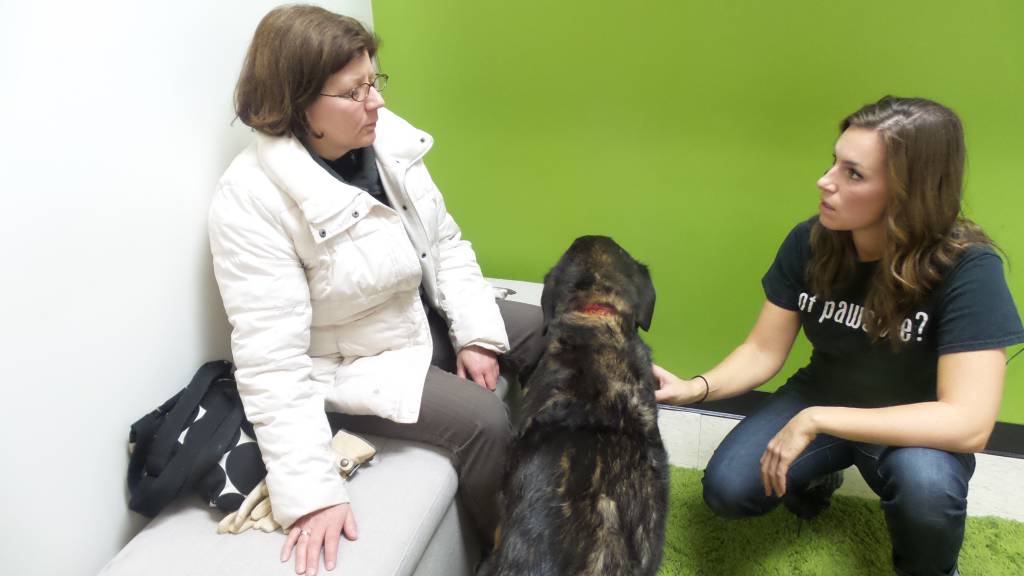Understanding TMJ Disorder in Our Pets

Chewing, barking, and fetching. All things you need your temporomandibular joint (TMJ) for, well, if you're a dog anyway. The TMJ is one of the most unique joints in both man and animal. It is a hinge joint that experiences a range of movement depending on the species. For example, canines have a TMJ that can move side to side, where felines have a very tight fitting joint that doesn’t allow any lateral movement.
Chewing, barking, and fetching. All things you need your temporomandibular joint (TMJ) for, well, if you're a dog anyway. The TMJ is one of the most unique joints in both man and animal. It is a hinge joint that experiences a range of movement depending on the species. For example, canines have a TMJ that can move side to side, where felines have a very tight fitting joint that doesn’t allow any lateral movement.
 Several ligaments cradle the mandible, or jawbone, and there are no bony attachments. A small, shock-absorbing articular disc made of fibrocartilage allows for smooth movement of the jaw. This disc is the main connector between the temporal bone, located in front of each ear, and the mandible. It is also the place where several ligaments attach. Since the disc is a separate structure with its own set of attachments, it has the capability to move within the joint and actually cause other disorders. Due to its unique nature, the TMJ consists of two joints (one on either side of the head) and it is impossible to produce movement in one without also affecting the other.
Several ligaments cradle the mandible, or jawbone, and there are no bony attachments. A small, shock-absorbing articular disc made of fibrocartilage allows for smooth movement of the jaw. This disc is the main connector between the temporal bone, located in front of each ear, and the mandible. It is also the place where several ligaments attach. Since the disc is a separate structure with its own set of attachments, it has the capability to move within the joint and actually cause other disorders. Due to its unique nature, the TMJ consists of two joints (one on either side of the head) and it is impossible to produce movement in one without also affecting the other.
One of the biggest problems humans have in this area is when the articular disc separates and stops functioning correctly. A similar issue can happen in animals, though far less often. This slippage can lead to a variety of problems which are often referred to as TMJ disorders. Symptoms of TMJ disorders include popping of the jaw, inability to open or close the mouth, notable deviation of the jaw, loss of appetite, pain, and any movement accompanied by crying.
What could cause this to happen in a dog or cat? Usually, carrying heavy things in the mouth that stress the joint, or trauma that results in a fracture. Diagnosis can be made based on a thorough history, exam and, X-ray. Unless the TMJ disorder is accompanied by osteoarthritis or a very clear dislocation, a diagnosis may come back as a non-diagnosis or completely normal. What fails to be recognized is the motion aspect of the TMJ disorder. If carrying a heavy object stresses the joint, it would be reasonable to suspect repetitive carrying of normal-to-heavy-weighted objects could contribute to a consistent micro trauma to the jaw. If this is the case, the jaw itself could be experiencing a structural shift or the upper cervical vertebrae could even be shifted; meaning the jaw would be changed based on biomechanics or the result of external and internal forces affects on it.
Though radiographs and a MRI can be helpful in diagnosing disorders, it is sometimes easy to overlook the true cause simply because it isn’t shown on these tools. For instance, if an X-ray reveals osteoarthritis in the TMJ joint, the question is what has caused there to be excess bony formation? That is an ongoing process and does not happen overnight, so whatever has lead to the osteoarthritis had to be present for a longer period of time.
A structural shift is often a good guess, as the body’s natural reaction to biomechanical changes is compensation through bony formation. If a structural shift is, in fact, the guilty party, it tends to be quite an easy fix. Adjustments to the jaw and the upper cervical region are gentle, non-invasive, and do not involve any dramatic movements. Improvement is often noted within one to two treatments and can take approximately four to six sessions to make that improvement a more permanent solution. Keep in mind with any animal, the likelihood that they will stop doing whatever it is that lead to the abnormal structure in the first place is small, and that protection is of the utmost importance.
If you're interested in learning more about how adjustments can help with overall pet health, please call The Pet Beastro at 248-458-3448 to find out about scheduling an appointment with Dr. Christina Cole of Advanced Animal Chiropractics, a chiropractor licensed and certified to work with animals. Or visit http://thepetbeastro.wpengine.com/services/animal-chiropractic-visits/ for more information on what to expect at an adjustment.
Please note that all chiropractic care is given with the consent of a veterinarian, veterinarian referral or in a veterinarian office. If you've scheduled an appointment, please bring this completed form with you:http://
References:
www.PetMD.com/dog/conditions/musculoskeletal/c_dg_temporomandibular_joint_disorders?page=2#
www.MyPetsDentist.com/pet-tmj-problems.pml
www.NCBI.NLM.NIH.gov/pmc/articles/PMC3747040/
www.AACFP.org/resources/unique_joint.cfm


Comments
Be the first to comment...